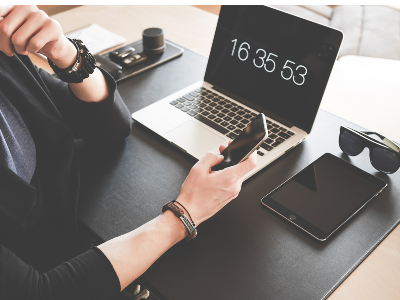If you run your business from home and have a dedicated area set aside as…
Working from home during COVID-19

We understand that due to COVID-19 your working arrangements may have changed. If you have been working from home, you may have expenses you can claim a deduction for at tax time.
Tracking these expenses can be challenging, so we have introduced a temporary shortcut method. It’s a simple way to calculate these expenses with minimal record keeping requirements. The shortcut method initially applied from 1 March to 30 June 2020, however it can now be applied up until 30 June 2021.
You can use the shortcut method to calculate your working at home expenses for the period between:
- 1 March to 30 June 2020 in your 2019–20 tax return
- 1 July to 30 June 2021 in your 2020–21 tax return.
We may extend this period, depending on when work patterns return to normal.
In most cases, if you are working from home as an employee, there will be no capital gains tax (CGT) implications for your home.
For more information about working from home prior to 1 March 2020, or the other methods you can use to calculate your working from home expenses, visit Home office expenses.
On this page:
- Claiming a deduction
- Expenses you can claim
- Expenses you can’t claim
- Calculating your expenses
- Shortcut method
- Records you must keep
Claiming a deduction
To claim a deduction for working from home, all the following must apply:
- you must have spent the money
- the expense must be directly related to earning your income
- you must have a record to prove it.
This means you can’t claim a deduction for items provided by your employer, or if you have been reimbursed for the expense. If you are not reimbursed by your employer, but receive an allowance from them to cover your expenses when you work from home, you:
- must include this allowance as income in your tax return
- can claim a deduction for the expenses you incur.
Expenses you can claim
If you work from home, you can claim a deduction for the additional expenses you incur. These include:
- electricity expenses associated with heating, cooling and lighting the area from which you are working and running items you are using for work
- cleaning costs for a dedicated work area
- phone and internet expenses
- computer consumables (for example, printer paper and ink) and stationery
- home office equipment, including computers, printers, phones, furniture and furnishings – you can claim either the
- full cost of items up to $300
- decline in value (depreciation) for items over $300.
Expenses you can’t claim
If you are working from home, you can’t claim:
- the cost of coffee, tea, milk and other general household items your employer may have provided for you at work
- costs related to children and their education, including setting them up for online learning, teaching them at home or buying equipment such as iPads and desks
- items that you’re reimbursed for, paid directly by your employer or the decline in value of items provided by your employer – for example, a laptop or a phone
- time spent not working, such as time spent home schooling your children or your lunch break.
Employees generally can’t claim occupancy expenses such as rent, mortgage interest, water and rates.
Calculating your expenses
For the 2019–20 income year, there are three ways of calculating home office expenses depending on your circumstances. The methods are the:
- Shortcut method (80 cents per work hour) – available 1 March to 30 June 2020 (this method can also be used during the period from 1 July 2020 to 30 June 2021 but that period will need to be claimed in your 2020–21 tax return)
- Fixed rate method (52 cents per work hour)
- Actual cost method.
You don’t have to use the shortcut method. You can choose to use one of the existing methods to calculate your deduction. You can use the method or methods that will give you the best outcome, as long as you meet the criteria and record keeping requirements for each method.
For information and examples on how to calculate your expenses prior to 1 March or to use the fixed rate or actual cost methods, see Home office expenses.
Shortcut method
You can claim a deduction of 80 cents for each hour you worked from home for the period between:
- 1 March 2020 to 30 June 2020 in your 2019–20 tax return
- 1 July 2020 to 30 June 2021 in your 2020–21 tax return.
If you:
- were working from home to fulfil your employment duties and not just carrying out minimal tasks such as occasionally checking emails or taking calls
- incurred additional running expenses as a result of working from home.
The shortcut method doesn’t require you to have a dedicated work area, such as a private study.
The shortcut method covers all additional deductible running expenses, including:
- electricity for lighting, cooling or heating and running electronic items used for work (for example, your computer), and gas heating expenses
- the decline in value and repair of capital items, such as home office furniture and furnishings including capital items that cost less than $300
- cleaning expenses
- your phone costs, including the decline in value of the handset
- your internet costs
- computer consumables, such as printer ink and stationery
- the decline in value of a computer, laptop or similar device.
You don’t have to incur all these expenses to use the shortcut method, but you must have incurred additional running expenses in some of these categories when working from home.
If you use this method, you can’t claim any other expenses for working from home for that period.
When you are calculating the number of hours you worked from home, you need to exclude any time you took a break from working.
You can calculate your working from home deduction using the shortcut method, with this formula:
- total number of hours worked from home from 1 March 2020 to 30 June 2020 × 80 cents (for the 2019–20 income year)
- total number of hours worked from home from 1 July 2020 to 30 June 2021 × 80 cents (for the 2020–21 income year).
If you use the shortcut method to claim a deduction, include the amount at the other work-related expenses question in your tax return and include ‘COVID-hourly rate’ as the description.
For information on how to calculate your working from home expenses prior to 1 March, or if you choose to use one of the existing home office expenses methods to calculate your deduction instead, see Home office expenses.
Records you must keep
You must keep a record of the hours you have worked from home. This could be a:
- timesheet
- roster
- diary
- similar document that shows the hours you worked.
If you use the other methods, you must also keep a record of the number of hours you worked from home along with records of your expenses.
More information
For more information on working from home, please contact our office on (03) 9848 5933.
Source: https://www.ato.gov.au/General/COVID-19/Support-for-individuals-and-employees/Employees-working-from-home/



